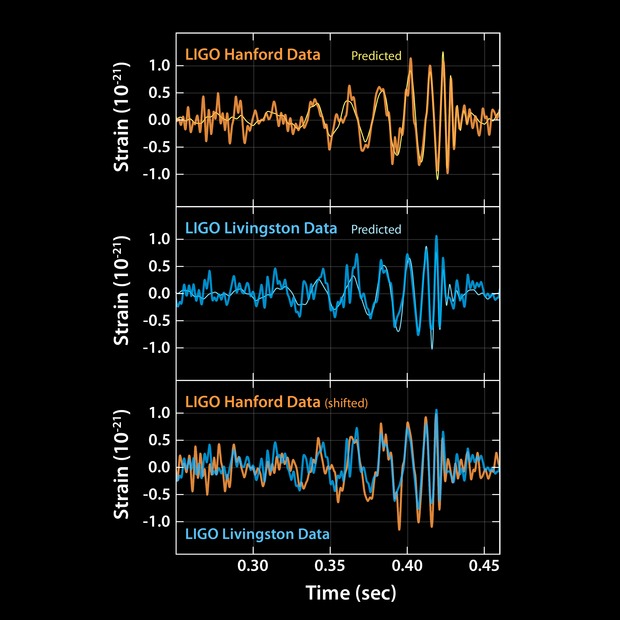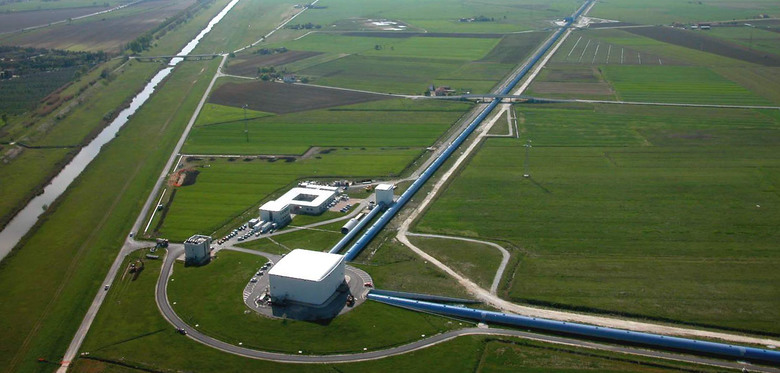The Voice of Space
Marcus ChownThe black hole merger detected by its gravitational waves on 14 September 2015 pumped out 50 times more power than all the stars in the Universe combined.

If you ask me whether there are gravitational waves or not, I must answer that I do not know. But it is a highly interesting problem. – Albert Einstein
Ladies and gentlemen, we did it. We have detected gravitational waves. – David Reitze, 11 February 2016
At Livingston in Louisiana is a 4-kilometre-long ruler made of laser light. Three thousand kilometres away in Hanford, Washington State, is an identical 4-kilometre-long ruler made of laser light. At 5.51 Eastern Daylight Time on 14 September 2015, a shudder went through the Livingston ruler. Seven milliseconds later – less than a hundredth of a second afterwards – an identical shudder went through the Hanford, ruler. It was the unmistakable signature of a passing gravitational wave – a ripple in the fabric of space-time itself, predicted to exist by Einstein almost exactly 100 years ago.

Plots showing the signals of gravitational waves detected by the twin LIGO observatories. Credit Caltech/MIT/LIGO Lab
The source of the gravitational waves was an extraordinary event. In a galaxy far, far away, at a time when the most complex organism on Earth was a bacterium, two monster black holes, were locked in a death-spiral. They whirled about each other one last time. They kissed and coalesced. And, in that instant, three times the mass of the Sun vanished. It re-appeared a split-second later as a tsunami of tortured space-time, propagating outwards at the speed of light.
The power in these gravitational waves exceeded the power output of all the stars in the Universe put together by a factor of 50. Or, to put in another way, had the black hole merger produced visible light rather than gravitational waves, it would have shone 50 times brighter than the entire Universe. This is the single most powerful event ever witnessed by human beings.
Gravitational waves are produced whenever mass is accelerated. Wave your hand in the air. You just generated gravitational waves. They are spreading outwards like ripples on a lake. Already, they have left the Earth. In fact, they have passed the Moon and are well on their way to Mars. And, in four years’ time, they will ripple through the nearest star system to the Sun. We know that one of the three stars of Alpha Centauri system is orbited by a planet. If that planet happens to be home to a technological civilisation that has built a gravitational wave detector, in four years’ time it will pick up the ripples in space-time that you made with your hand a moment ago.

The Cirgo Detector at Caltech. Credit: Virgo collaboration
The only problem is that they will be very weak. Imagine a drum. It is easy to vibrate it because a drum skin is flexible. But space-time is a billion billion billion times stiffer than steel. Imagine trying to vibrate a drum skin that is a billion billion billion times stiffer than steel. This is why only the most violent cosmic events such as the merger of black holes create significant vibrations of space-time.
But those vibrations, like ripples spreading on a lake, die away rapidly. When they arrived on Earth on 14 September 2015, they had been travelling for 1.3 billion years across space and were fantastically tiny. As they passed the 4 kilometre rulers at Hanford and Livingston, they alternately stretched and squeezed them – but by only one-hundred millionth of the diameter of an atom! To give you some idea of how small that is, it would take about 10 million atom said end to end to span the full stop at the end of this sentence. The fact that the twin rulers of the “Laser Interferometric Gravitational-wave Observatory”, or LIGO, could detect such a small effect is extraordinary. LIGO is a technological tour de force. At each site, there are actually two tubes 1.2 metres in diameter, which form an L-shape down which a megawatt of laser light travels in a vacuum better than interplanetary space. At each end, the light bounces off 42-kilogram mirrors, suspended by glass fibres just twice the thickness of a human hair and so perfectly smooth that they reflect 99.999 per cent of all incident light. It is the microscopic movement of these suspended mirrors that signals a passing gravitational wave. So sensitive is the machine that it was knocked off kilter by an earthquake in China.
To detect gravitational waves, the LIGO physicists had to do something extraordinary: spot a change in length of their 4-kilometre ruler by just 1 part in 1,000,000,000,000,000,000,000. No wonder the 2017 Nobel Prize was awarded to three of the physicists who had pioneered the experiment: Rainer “Rai” Weiss, Kip Thorne and Barry Barish.
Since the first detection of gravitational waves on Earth, gravitational waves have been picked up from a total of five events. Four were from the merger of pairs of black holes and one from the merger of super-compact neutron stars. The latter event, observed in 17 August 2017, is the most significant because, as well as gravitational waves, it created light, which was picked up by telescopes all over the world. Analysis of the light revealed that the fireball forged at least ten times the mass of the Earth in pure gold.

Artist impression of the merging of two neutron stars Credit: NSF/LIGO/Sonoma State University/A. Simonnet
It has long been known that we were made in Heaven – that we are stardust made flesh. The iron in your blood, the calcium in your bones, the oxygen that fills your lungs each time you take breath – all were forged inside stars which lived and died before the Earth was born. But scientists have long wondered where gold came from. Now, at last, they know. If you have a gold bracelet or watch, its material was forged in the cataclysmic collision of neutron stars billions of years ago. Can there be a more striking example of the intimate connection between the mundane and close-to-home and the cosmic and far away?
The significance of directly detecting gravitational waves cannot be over-stated. Imagine you have been deaf since birth, then, suddenly, overnight, you are able to hear. This is how it is for physicists and astronomers. For all of history they have been able to “see” the Universe. Now, at last, they can “hear” it. Gravitational waves are the voice of space. It is not too much of an exaggeration to say that their detection is the most important development in astronomy since the invention of the astronomical telescope by Galileo in 1609.
On 14 September 2015, at the very edge of audibility, we heard a faint sound like the rumble of distant thunder. But we have yet to hear the gravitational wave equivalent of baby crying or music playing or a bird singing. Over the next few years, as LIGO increases its sensitivity and other detectors come online in Europe, Japan and eventually India, our ability to detect gravitational waves will get better. Who knows what we will hear as we tune into the cosmic symphony?
“The Voice of Space” is just one of the topics included in Marcus Chown’s new is book, Infinity in the Palm of Your Hand: 50 Wonders that Reveal an Extraordinary Universe which is out now.
The Cosmic Shambles Network relies on your support on pledges via Patreon so we can continue to provide great, new, exciting content without the need for third party ads or paywalls.
For as little as $1 a month you can support what we do and get some great rewards for doing so as well. Click the Patreon logo to pledge or find out more.

Marcus Chown is an award-winning writer and broadcaster. Marcus was formerly a radio astronomer at the California Institute of Technology in Pasadena where studied under Richard Feynman and gained a Master of Science in Astrophysics. He is cosmology consultant of New Scientist and has written a number of best selling popular science books including We Need to Talk About Kelvin and Afterglow of Creation. He is @marcuschown on Twitter.
If you would like to reuse this content please contact us for details
Subscribe to The Cosmic Shambles Network Mailing list here.


